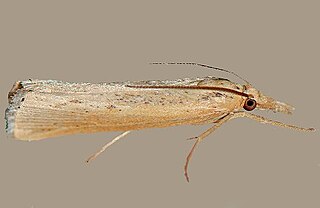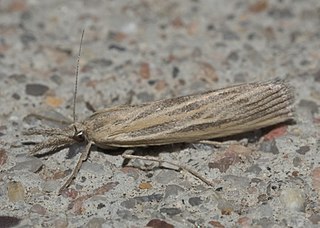
The Pyralidae, commonly called pyralid moths, snout moths or grass moths, are a family of Lepidoptera in the ditrysian superfamily Pyraloidea. In many classifications, the grass moths (Crambidae) are included in the Pyralidae as a subfamily, making the combined group one of the largest families in the Lepidoptera. The latest review by Eugene G. Munroe and Maria Alma Solis retain the Crambidae as a full family of Pyraloidea.

The Pyraloidea are a moth superfamily containing about 16,000 described species worldwide, and probably at least as many more remain to be described. They are generally fairly small moths, and as such, they have been traditionally associated with the paraphyletic Microlepidoptera.

Spilomelinae is a very species-rich subfamily of the lepidopteran family Crambidae, the crambid snout moths. With 4,135 described species in 344 genera worldwide, it is the most speciose group among pyraloids.

In biological taxonomy, circumscription is the content of a taxon, that is, the delimitation of which subordinate taxa are parts of that taxon. If we determine that species X, Y, and Z belong in Genus A, and species T, U, V, and W belong in Genus B, those are our circumscriptions of those two genera. Another systematist might determine that T, U, V, W, X, Y, and Z all belong in genus A. Agreement on circumscriptions is not governed by the Codes of Zoological or Botanical Nomenclature, and must be reached by scientific consensus.
Arenochroa is a genus of moths of the family Crambidae. It contains only one species, Arenochroa flavalis, which is found in Mexico and the United States, where it has been recorded from Arizona, Nevada and California.
Nannobotys is a genus of moths of the family Crambidae. It contains only one species, Nannobotys commortalis, which is found in North America, where it has been recorded from eastern Washington to California and Nevada.
Pseudoschoenobius is a genus of moths of the family Crambidae. It contains only one species, Pseudoschoenobius opalescalis, which is found in North America, where it has been recorded from Alberta, Illinois, Indiana, New Mexico and California. The habitat consists of dry, sandy areas.
Plumipalpiella is a genus of moths of the family Crambidae. It contains only one species, Plumipalpiella martini, which is found in North America, where it has been recorded from California.

Tehama is a genus of moths of the family Crambidae. It contains only one species, Tehama bonifatella, the western lawn moth, which is found in Greenland and North America, where it has been recorded from Alberta, British Columbia, California, Colorado, Labrador, Manitoba, Nevada, Quebec and Washington. The habitat consists of grasslands.

Amyelois is a monotypic snout moth genus described by Hans Georg Amsel in 1956. Its single species, Amyelois transitella, the navel orangeworm, described by Francis Walker in 1863, is endemic to the tropical Western Hemisphere, including the southern United States. Its abundance in California increased greatly during the first half of the 20th century.

Apomyelois bistriatella is a species of snout moth in the genus Apomyelois. It was described by George Duryea Hulst in 1887. It is known from California, the eastern United States, northern Europe and Russia.

Palpita gracialis, the gracile palpita moth, is a moth of the family Crambidae. It is found in North America, from California to Texas and Oklahoma.

Glaphyriinae is a subfamily of the lepidopteran family Crambidae. It was described by William Trowbridge Merrifield Forbes in 1923. The subfamily currently comprises 509 species in 75 genera.

Scopariinae is a subfamily of the lepidopteran family Crambidae. The subfamily was described by Achille Guenée in 1854.

Thaumatopsis pexellus, the woolly grass-veneer, is a moth in the family Crambidae. It was described by Philipp Christoph Zeller in 1863. It is found in most of North America. The habitat consists of grasslands.
Stegea salutalis is a moth in the family Crambidae. It is found in North America, where it has been recorded from Arizona, British Columbia, California, Colorado, Montana, New Mexico, Oregon, Texas and Utah. In the south, the range extends to north-western Mexico.

Pyrausta perrubralis is a moth in the family Crambidae. It was described by Packard in 1873. It is found in North America, where it has been recorded from British Columbia, California, New Mexico, Oregon and Washington.

Pyrausta unifascialis, the one-banded pyrausta, is a moth in the family Crambidae. It was described by Alpheus Spring Packard in 1873. It is found in North America, where it has been recorded from Quebec west to British Columbia, south to Arizona and California. The habitat consists of forest openings, clearings and fields.

Conchylodes octonalis, the eight-barred lygropia moth, is a snout moth in the family Crambidae. It was described by Zeller in 1873. It is found in North America, where it has been recorded from central and southern California to Texas and from Iowa, Mississippi, Nevada, New Mexico, Oklahoma and Tennessee. The habitat consists of low-elevation arid areas.

Udea profundalis is a moth in the family Crambidae. It was described by Packard in 1873. It is found in North America, where it has been recorded from British Columbia, through Washington, Oregon and Nevada to California and Texas. Records east of the Rocky Mountains, refer to Udea rubigalis.














